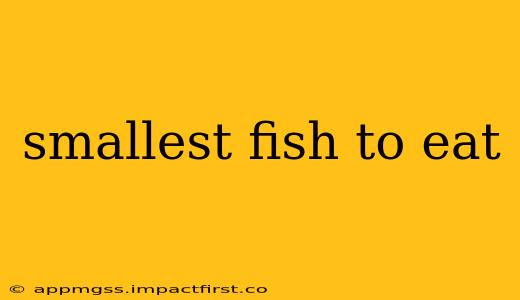Finding the smallest fish to eat can be tricky, as "smallest" is subjective and depends on what's readily available and considered safe for consumption. This guide explores some of the tiniest edible fish, offering considerations for responsible sourcing and preparation. We'll also address some frequently asked questions surrounding small fish consumption.
What are some of the smallest fish that are safe to eat?
Several tiny fish are commonly consumed globally, though their availability varies significantly by region. Examples include:
-
Anchovies: These silvery fish are incredibly small and are often found packed in oil or used as a pizza topping. They are packed with flavor and nutrients.
-
Sardines: Slightly larger than anchovies, sardines are still considered among the smaller edible fish. They're a fantastic source of omega-3 fatty acids and are often canned or grilled.
-
Whitebait: This term often refers to a mix of small fish species, typically including sprats, sardines, and others. They're frequently eaten fried or as part of a larger dish.
-
Shrimp (small varieties): While technically crustaceans, not fish, small shrimp are worth mentioning. Many species are quite small, and they provide a delicate, sweet flavor.
It's crucial to remember that the size of the fish doesn't solely determine its edibility. Always ensure your fish comes from a reputable source, adhering to local regulations and sustainability guidelines. Smaller fish can be more susceptible to contamination, so careful sourcing is paramount.
Are there any risks associated with eating very small fish?
Yes, there are potential risks, mainly concerning:
-
Mercury contamination: Smaller fish can accumulate mercury from their environment. While larger fish often contain higher levels, it's still important to be mindful of consumption, especially for pregnant women or young children.
-
Parasites: Some small fish might carry parasites. Thorough cooking generally eliminates this risk.
-
Bone count: Tiny fish often have many small bones, requiring careful preparation and consumption to avoid choking hazards.
What are the benefits of eating small fish?
Despite the potential risks, small fish like sardines and anchovies offer considerable nutritional benefits:
-
High in omega-3 fatty acids: Essential for heart health and brain function.
-
Rich in protein: A crucial component for building and repairing tissues.
-
Good source of vitamins and minerals: Including vitamin D, calcium, and iron.
How can I prepare small fish safely?
Proper preparation is key to ensuring safe consumption of small fish:
-
Thorough cooking: This eliminates potential parasites and reduces mercury concerns (although it doesn't remove all mercury).
-
Careful deboning: Small fish bones can be difficult to remove, so careful attention is required, especially when preparing for children.
-
Reputable sourcing: Choose your fish from trusted suppliers who prioritize sustainable practices and adhere to safety regulations.
Where can I find small fish to buy?
Small fish are most readily found in:
-
Specialty fishmongers: These stores often stock a wider variety of fish, including smaller species.
-
Asian markets: These markets frequently carry small fish, often prepared in unique ways.
-
Canned or jarred: Many small fish, such as sardines and anchovies, are commonly available in cans or jars.
Are all small fish good to eat?
No. Not all small fish are safe or palatable for human consumption. Some species might be poisonous, while others simply might not be tasty. It's crucial to identify the species and check its edibility before consumption. Research your local edible fish varieties to ensure you're choosing safe options.
This guide provides a general overview. Always consult with local experts or refer to trustworthy seafood guides to identify safe and delicious small fish in your area. Remember responsible sourcing and preparation are key to enjoying these tiny but tasty seafood options.
